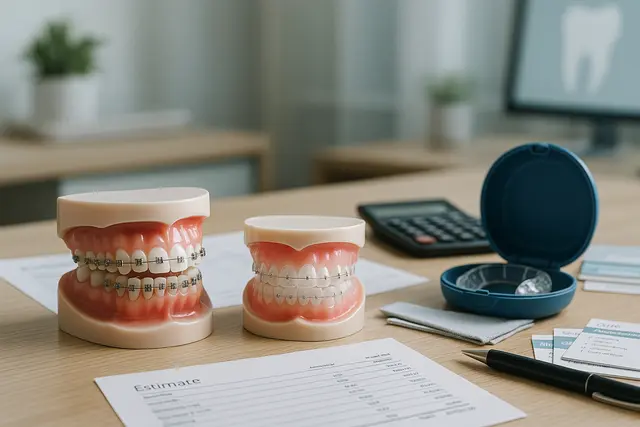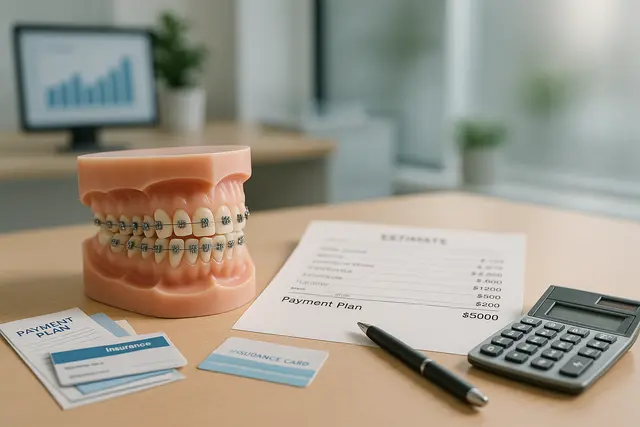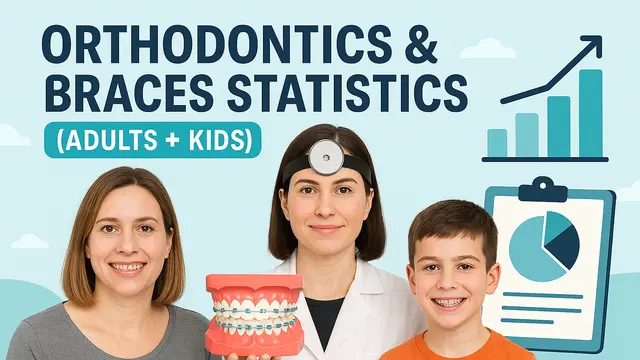Orthodontics
7 min read
Apr 03, 2025
Choosing the Right Orthodontist for Your Braces: 10 Essential Questions
Choosing an orthodontist is a key step in improving your dental health and appearance. Braces are a long-term treatment, and working with the right professional makes the process smoother, more effective, and less stressful. Orthodontic care involves both clinical skill and communication, so asking the right questions helps you make an informed decision.

1. How much experience do you have with cases like mine?
Not all orthodontic cases are alike. Crowded teeth, crossbites, open bites, and other alignment issues each come with their own nuances. The orthodontist’s ability to manage your specific condition depends heavily on past experience with similar situations.
What to listen for:
Ask directly if they’ve treated cases like yours and how often. The goal is to gauge whether this is familiar ground for them. They should be able to explain typical outcomes for someone with your type of case and the timeline you might expect. Pay attention to how clearly and confidently they answer, vague or overly general responses can be a red flag.
Also, consider the variety of treatments they’ve performed. A practice that sees a wide range of cases is more likely to be equipped to adapt if your treatment needs shift over time. The more context they bring from experience, the more likely they are to spot potential issues early and adjust accordingly.
2. Are you a board-certified orthodontist?
Certification from the American Board of Orthodontics (ABO) isn’t required to practice, but it sets a higher bar. To become board-certified, an orthodontist must complete extra exams beyond dental school and orthodontic residency, demonstrating proficiency in diagnosis, treatment planning, and clinical outcomes. It also signals a commitment to continuing education and accountability.
What to know:
Only licensed orthodontic specialists, those who completed full orthodontic residency programs, are eligible for ABO certification. General dentists offering braces or clear aligners are not. While board certification doesn’t guarantee better results, it does show that the orthodontist has passed one of the most rigorous voluntary processes in the field. That can matter when choosing who to trust with your long-term bite and alignment.
3. What types of braces do you offer?
Not all braces are created equal, and not every practice provides a full range of options. At a minimum, orthodontists generally offer traditional metal braces. Many also include ceramic (tooth-colored) braces, lingual braces that sit behind the teeth, and removable systems like Invisalign or other clear aligners. Knowing what’s available matters because the right appliance depends on your specific diagnosis, lifestyle, and cosmetic goals.
Why this matters:
Each type of brace comes with trade-offs. Metal braces are durable and cost-effective but also the most noticeable. Ceramic braces blend in with teeth but are more fragile. Lingual braces are hidden from view but can be uncomfortable and more challenging to adjust. Clear aligners offer convenience and discretion but are best for mild to moderate cases and rely heavily on patient compliance.
Ask what the orthodontist regularly uses in practice, not just what they technically offer. Specialists who are well-versed in multiple systems can make objective recommendations based on your bite, oral habits, and treatment goals, not their preferences or business model.
4. How do you create your treatment plans?
Orthodontic treatment should never be one-size-fits-all. The tools and methods your orthodontist uses to map out your treatment affect how accurate, efficient, and comfortable the process will be.
Ask about the planning process in detail: Do they take physical molds using dental putty, or do they use digital scanners to capture a 3D image of your teeth? Are X-rays and photographs part of the process? Advanced offices often use cone beam CT imaging or digital treatment software to build simulations and predict tooth movement more precisely.
Why it matters: Modern methods typically yield better results and fewer surprises during treatment. Digital scans tend to be more comfortable than molds, and advanced software allows orthodontists to plan movements more accurately, potentially reducing the length of treatment and the number of corrections needed. It also makes it easier to monitor progress.
Bottom line, ask how your case will be evaluated and planned. A well-thought-out approach can mean fewer delays and a smoother experience from start to finish.
5. How often will I need to come in for checkups?
Most orthodontic treatments require regular monitoring, usually every 4 to 8 weeks. These appointments allow the orthodontist to make adjustments, check progress, and catch any issues before they become bigger problems.
What to ask:
Be direct about your schedule. Can appointments be made early in the morning, late afternoon, or on weekends? Does the office accommodate students or working adults? Reliable checkups are essential to staying on track. Delays can lengthen your treatment or compromise results.
Also, confirm whether these visits are included in your treatment fee or billed separately. Knowing what to expect, both in terms of time and cost, helps you plan ahead.
6. What’s included in the total cost of treatment?
Braces can be a significant financial commitment, and treatment costs vary widely depending on the provider, the complexity of your case, and the type of braces chosen. Before agreeing to anything, get a breakdown of every element included in your proposed treatment.
Look for:
A detailed, written estimate that lists what the total fee covers, not just a lump sum. Does it include diagnostic records like X-rays and scans? Will you be charged separately for each adjustment or is that rolled into the base cost? Make sure to ask whether retainers are included after active treatment ends. You should also clarify whether minor emergencies or unexpected visits will incur extra charges.
Insurance coverage is another key point. Ask whether the office accepts your dental insurance and how much it typically covers. Also review available payment plans or financing options. Orthodontic care often stretches over a year or more, so knowing your monthly responsibilities, and whether there are any hidden fees, can prevent financial strain later.
7. What is your emergency policy?
Brackets come loose. Wires shift. Emergencies happen.
Why to ask:
Problems don't always follow office hours. When a wire pokes your cheek on a Saturday or a bracket breaks mid-week, you need to know what help is available.
Ask whether the office has a protocol for urgent issues, same-day appointments, after-hours contact, or temporary fixes over the phone. Some practices reserve time for emergencies; others may refer you elsewhere.
Also, clarify the cost. Are minor unscheduled visits for issues like discomfort or broken appliances included in your treatment fee, or billed separately? Not all plans cover emergency tweaks.
Knowing how the office handles problems between regular visits gives you peace of mind and limits disruptions during treatment.
8. Can I see before-and-after photos from your previous patients?
Before-and-after images serve as a track record. They show you what the orthodontist has accomplished, and more importantly, what they can do for someone with needs like yours.
How to evaluate:
Don’t just look for perfect smiles. Focus on patients who started with issues similar to yours, crowding, gaps, overbites, or bite alignment. Examine whether the end results show balanced, functional improvements, not just cosmetic ones. Ask the orthodontist to walk you through a few cases. How long those treatments took, which methods were used, and what challenges they overcame matter as much as the photos themselves.
Keep in mind: real results build trust. An orthodontist unwilling to share this kind of work may not have the experience or transparency you want.
9. What happens if treatment takes longer than expected?
Orthodontic treatment doesn’t always follow the original timeline. Teeth may move slower than predicted, and missed appointments or broken appliances can lead to delays.
Ask about:
The orthodontist's policy on extended treatment. Do additional months come with extra fees, or is that cost already included? Will your monitoring schedule change? Some providers build flexibility into their fee structure, while others may charge for added visits or appliance replacements.
A clear answer here helps you avoid surprise costs and sets realistic expectations. More importantly, it shows whether the practice communicates openly when plans need to shift. A good orthodontist knows how to adapt the approach if your teeth don’t follow the script, and keeps you informed every step of the way.
10. What kind of follow-up care do you offer after braces are removed?
Getting your braces off isn’t the end of treatment, it’s the beginning of maintenance. Teeth can shift without proper follow-up, so it’s important to understand what kind of long-term care is part of the package.
Confirm the plan:
Start by asking what type(s) of retainer the orthodontist recommends. There are fixed (bonded) and removable options, and each has advantages depending on your case. You’ll also want to clarify how long you’ll need to wear it, some patients are advised to wear retainers nightly for life.
Next, ask how follow-up is structured. Many orthodontists schedule periodic check-ins after braces are removed, especially during the first year. These visits help monitor movement and catch issues early.
Finally, verify what happens if problems arise, like a cracked retainer or shifting teeth. Some offices include post-treatment support as part of your original cost, while others charge separately.
Long-term results rely on consistency and communication. A detailed follow-up plan protects your investment and keeps your teeth where they should be.
Why Is It Important to Ask About the Orthodontist’s Experience With Cases Like Mine?
Each orthodontic case is unique, and the orthodontist’s ability to manage yours depends on their experience with similar conditions. Ask how often they treat patients with your specific issue, such as open bites, crowding, or crossbites, and what outcomes they typically achieve. The more targeted their experience, the more confidently they can customize your treatment and anticipate any complications.
What Does Board Certification Mean for an Orthodontist?
Board certification from the American Board of Orthodontics is a voluntary credential that signifies an orthodontist has passed additional clinical exams beyond dental and orthodontic school. It reflects a commitment to high standards, continued education, and expert-level care. While it’s not required, it can give you more confidence in your provider’s skills and accountability.
Why Should I Know Which Types of Braces the Orthodontist Offers?
Different types of braces suit different needs, lifestyles, and goals. Metal braces are durable, clear aligners offer discretion, and lingual or ceramic options offer a blend of aesthetics and function. Asking about available options ensures your treatment is tailored to you, not just what the office prefers to use. The more variety they offer, the more flexible and objective their recommendations will likely be.
What Should I Understand About the Orthodontist’s Treatment Planning Process?
A modern, customized treatment plan often involves digital scans, X-rays, and 3D modeling to map out precise tooth movement. This leads to better accuracy, fewer surprises, and potentially shorter treatment times. Ask how your orthodontist plans and monitors progress so you know whether they’re using current tools to guide your treatment effectively and efficiently.
Read Next
Related Posts

Orthodontics
Retainer That Looks like Braces: Benefits for Long-Term Alignment
A retainer might not get as much attention as braces, but it plays a crucial role in maintaining your smile after orthodontic treatment. Whether you're new to retainers or curious about the type that looks like braces, understanding their purpose and benefits is key to keeping your teeth aligned for the long haul.
6 min read
Sep 15, 2025

Orthodontics
How Much Are Metal Braces? Cost Comparison With Other Options
Thinking about getting braces but overwhelmed by the cost? You’re not alone. Orthodontic treatment can be a major investment, and understanding the different price points, from metal braces to clear aligners, can help you make a smart, confident decision.
5 min read
Sep 15, 2025

Orthodontics
Orthodontics & Braces Statistics (Adults + Kids)
Orthodontics has transformed from a niche medical service for teenagers into a booming sector that spans all ages. Today, both adults and children seek orthodontic treatment to improve their smiles, fix bite issues, and boost self-confidence.
4 min read
Aug 21, 2025
Don’t have time to research every dentist around you?
See why 30k+ patients trusted us